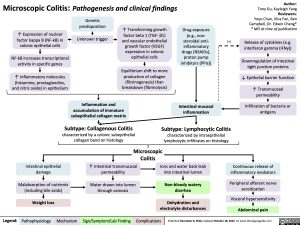Microscopic Colitis: Pathogenesis and clinical findings Genetic
Author: Tony Gu, Kayleigh Yang Reviewers: Yoyo Chan, Vina Fan, Ben Campbell, Dr. Edwin Cheng* * MD at time of publication
Release of cytokines (e.g. interferon gamma (IFNγ))
Downregulation of intestinal tight junction proteins
↓ Epithelial barrier function
↑ Transmucosal permeability
Infiltration of bacteria or antigens
↑ Expression of nuclear factor kappa B (NF-kB) in colonic epithelial cells
NF-kB increases transcriptional activity in specific genes
↑ Inflammatory molecules
(histamine, prostaglandins, and nitric oxide) in epithelium
predisposition Unknown trigger
↑ Transforming growth factor beta 1 (TGF- β1)
and vascular endothelial growth factor (VEGF) expression in colonic epithelial cells
Equilibrium shift to more production of collagen
(fibrinogenesis) than breakdown (fibrinolysis)
Drug exposure (e.g., non-
steroidal anti- (+)
inflammatory drugs (NSAIDs), proton pump inhibitors (PPIs))
Inflammation and accumulation of immature subepithelial collagen matrix
Subtype: Collagenous Colitis
Intestinal mucosal inflammation
Subtype: Lymphocytic Colitis
characterized by a colonic subepithelial characterized by intraepithelial
collagen band on histology
lymphocytic infiltrates on histology
Microscopic Colitis
Intestinal epithelial damage
Malabsorption of nutrients (including bile acids)
Weight loss
↑ Intestinal transmucosal permeability
Water drawn into lumen through osmosis
Ions and water back leak into intestinal lumen
Non-bloody watery diarrhea
Dehydration and electrolyte disturbances
Continuous release of inflammatory mediators
Peripheral afferent nerve sensitization
Visceral hypersensitivity
Abdominal pain
Legend:
Pathophysiology
Mechanism
Sign/Symptom/Lab Finding
Complications
Published December 8, 2018, Updated October 18, 2022 on www.thecalgaryguide.com
Foundations
Systems
Other Languages
Gastroenterology Inflammatory Bowel Disease Microscopic Colitis: Pathogenesis and Clinical Findings microscopic-colitis-pathogenesis-and-clinical-findings

